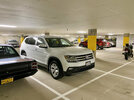I would get additional quotes from other electricians.
The Wall Connector price ($500) is more than 50% offset by the items you don't need, would need or want to have if you install the NEMA 14-50 receptacle.
Required for NEMA 14-50 Receptacle:
1) 50A GFCI circuit breaker ($100) - Required
2) Junction box and high quality NEMA 14-50 receptacle (i.e. Hubbell, Bryant or Cooper; not Leviton) ($100) - Required
3) Cable Organizer ($35) - Would want to have.
4) 3 wire (plus ground wire) for a total of 4 wires, in conduit. For a long wire run this could easily add $100 to the cost of the materials. (Labor to install the wire would be the same for the Wall Connector.) - Required
Required for Wall Connector:
1) Tesla Wall Connector ($500)
2) standard circuit breaker ($10)
3) 2 wire (plus ground wire) for a total of 3 wires, in conduit.
The Wall Connector can be installed on any circuit from 15A up to 60A. Since the distance from your service panel to the garage is 160 ft it may make sense to install a sub panel in the garage, use aluminum wire versus copper wire as the cost of aluminum wire is currently ~25% of the cost of copper wire. (Large gauge aluminum wire is used all of the time for bringing power into the home from the meter to the service panel.) You could install a 100A sub panel, be able to add an additional charging circuit in the future.
When installed on a 50A circuit the Wall Connector can charge at 40A. The Tesla Mobile Connector when used with the NEMA 14-50 plug adapter is limited to 32A. As you stated your current driving is limited to ~60 miles per day. Any 240V charging setup from 20A up to 60A would meet your current charging needs.
The Wall Connector supports automatic load balancing; up to 4 Wall Connectors can share a single charging circuit. (This may not be something you would need.)
The Wall Connector is designed to be installed inside a garage or outdoors. (This does not matter as you plan to install the charging circuit inside your garage.)



